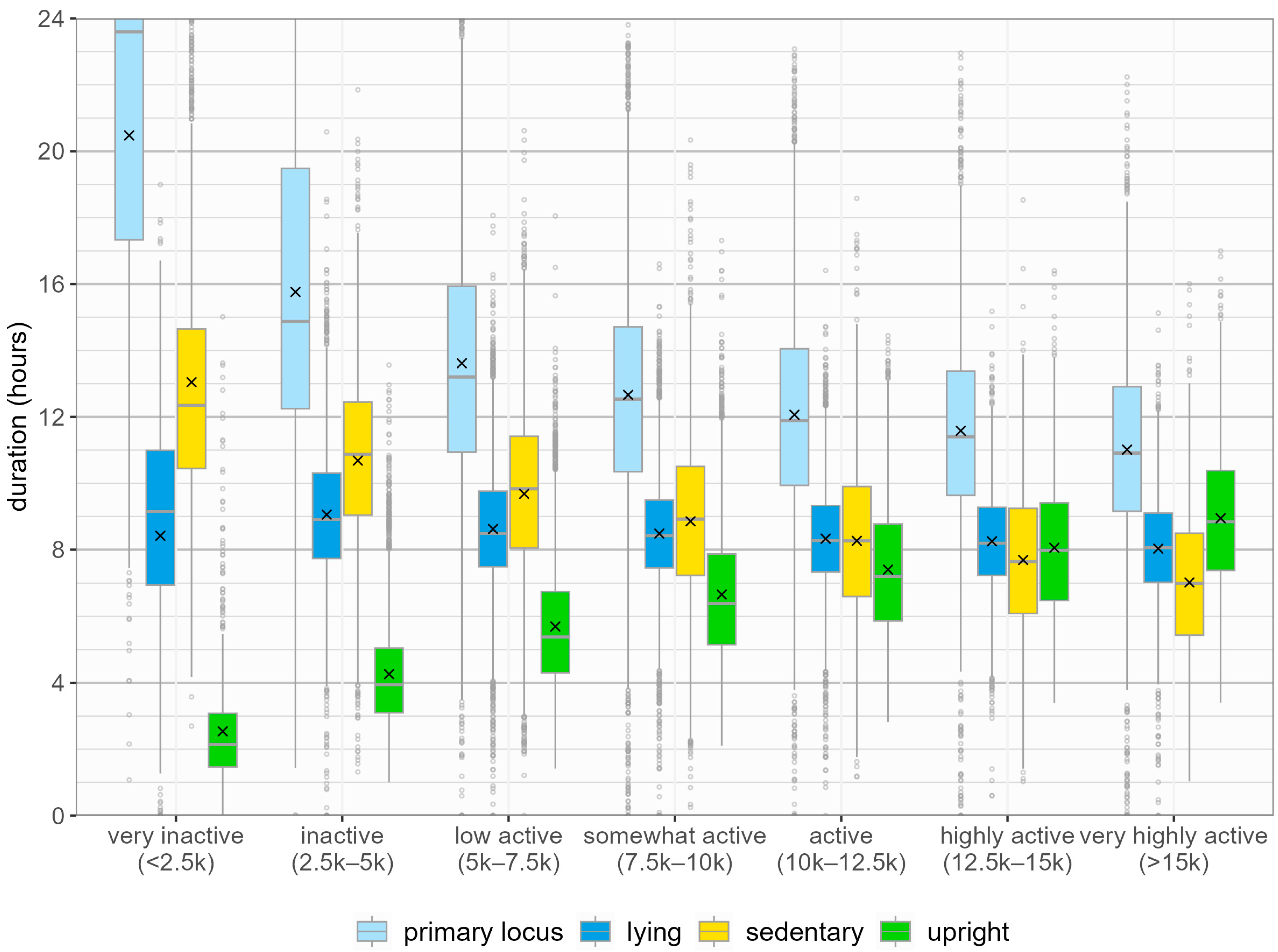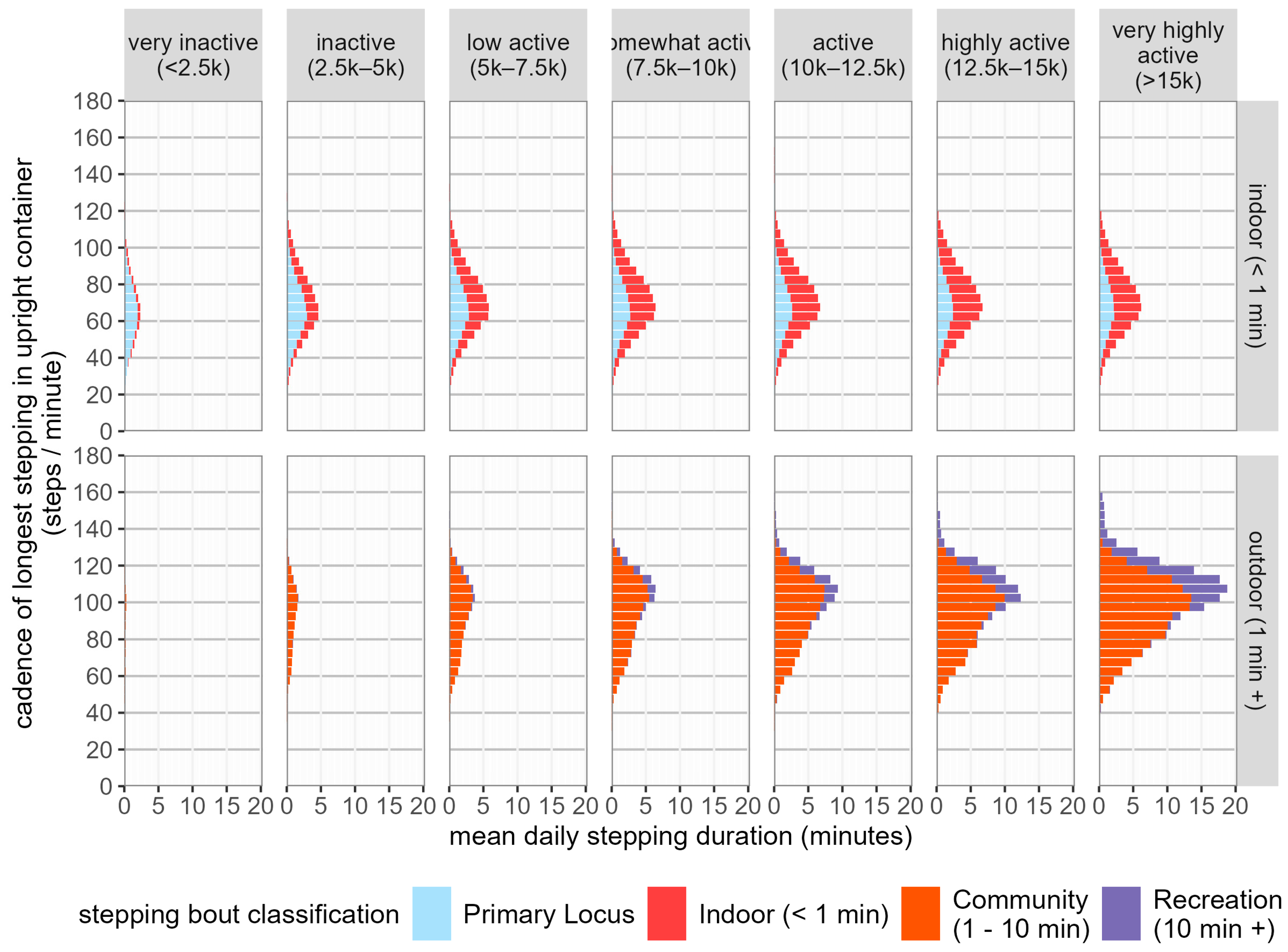The Relationship Between Daily Activity Level, Posture Distribution, Stepping Patterns, and Cadence in the BCS70 Cohort
Abstract
1. Introduction
2. Materials and Methods
2.1. Study Design
2.2. Physical Activity Measurement
- continuous stepping longer than one minute
- a period of seated transport
- a period of cycling
2.3. Classification of Days by Step Count
2.4. Classification of Days by Posture Composition
- Lying—primary lying;
- Sedentary—sedentary, secondary lying, or seated transport;
- Upright—quiet standing, stepping, or cycling.
2.5. Quantification of Stepping Behaviour by Upright Container
2.6. Association of Activity Level with Time Spent in Primary Postures
2.7. Association of Activity Level with Stepping Behaviour
3. Results
3.1. Posture Allocation and Activity Level
3.2. Stepping Behaviour and Activity Level
3.3. Stepping Cadence and Activity Level
4. Discussion
5. Conclusions
Author Contributions
Funding
Institutional Review Board Statement
Informed Consent Statement
Data Availability Statement
Acknowledgments
Conflicts of Interest
References
- Rosenberger, M.E.; Fulton, J.E.; Buman, M.P.; Troiano, R.P.; Grandner, M.A.; Buchner, D.M.; Haskell, W.L. The 24-Hour Activity Cycle: A New Paradigm for Physical Activity. Med. Sci. Sports Exerc. 2019, 51, 454–464. [Google Scholar] [CrossRef]
- Mansoubi, M.; Pearson, N.; Biddle, S.J.; Clemes, S. The relationship between sedentary behaviour and physical activity in adults: A systematic review. Prev. Med. 2014, 69, 28–35. [Google Scholar] [CrossRef] [PubMed]
- Amagasa, S.; Fukushima, N.; Kikuchi, H.; Oka, K.; Chastin, S.; Tudor-Locke, C.; Owen, N.; Inoue, S. Older Adults’ Daily Step Counts and Time in Sedentary Behavior and Different Intensities of Physical Activity. J. Epidemiol. 2021, 31, 350–355. [Google Scholar] [CrossRef] [PubMed]
- Clemes, S.A.; Patel, R.; Mahon, C.; Griffiths, P.L. Sitting time and step counts in office workers. Occup. Med. 2014, 64, 188–192. [Google Scholar] [CrossRef]
- Bisson, A.N.S.; Robinson, S.A.; Lachman, M.E. Walk to a better night of sleep: Testing the relationship between physical activity and sleep. Sleep Health 2019, 5, 487–494. [Google Scholar] [CrossRef] [PubMed]
- Kimura, N.; Aso, Y.; Yabuuchi, K.; Matsubara, E. Association between objectively measured walking steps and sleep in community-dwelling older adults: A prospective cohort study. PLoS ONE 2020, 15, e0243910. [Google Scholar] [CrossRef]
- Mead, M.P.; Baron, K.; Sorby, M.; Irish, L.A. Daily Associations Between Sleep and Physical Activity. Int. J. Behav. Med. 2019, 26, 562–568. [Google Scholar] [CrossRef]
- Mahesworo, B.; Budiarto, A.; Hidayat, A.A.; Soeparno, H.; Pardamean, B. Sleep quality and daily activity association assessment from wearable device data. In Proceedings of the 2020 International Conference on Information Management and Technology (ICIMTech), Bandung, Indonesia, 13–14 August 2020; pp. 197–202. [Google Scholar]
- Schwartz, B.D.; Shivgulam, M.E.; Petterson, J.L.; Wu, Y.; Frayne, R.J.; Kimmerly, D.S.; O’brien, M.W. More moderate-intensity physical activity and less prolonged sedentary time are associated with better very short-term systolic blood pressure variability in healthy adults. J. Hum. Hypertens. 2023, 37, 1015–1020. [Google Scholar] [CrossRef] [PubMed]
- Stens, N.A.; Bakker, E.A.; Mañas, A.; Buffart, L.M.; Ortega, F.B.; Lee, D.-C.; Thompson, P.D.; Thijssen, D.H.; Eijsvogels, T.M. Relationship of Daily Step Counts to All-Cause Mortality and Cardiovascular Events. J. Am. Coll. Cardiol. 2023, 82, 1483–1494. [Google Scholar] [CrossRef] [PubMed]
- Tudor-Locke, C.; Bassett, D.R. How many steps/day are enough? Preliminary pedometer indices for public health. Sports Med. 2004, 34, 1–8. [Google Scholar] [CrossRef]
- Speirs, C.; Granat, M.; Stamatakis, E.; Hamer, M. Estimating changes in physical behavior during lockdowns using accelerometry-based simulations in a large UK cohort. Scand. J. Med. Sci. Sports 2021, 31, 2221–2229. [Google Scholar] [CrossRef]
- Granat, M.; Clarke, C.; Holdsworth, R.; Stansfield, B.; Dall, P. Quantifying the cadence of free-living walking using event-based analysis. Gait Posture 2015, 42, 85–90. [Google Scholar] [CrossRef] [PubMed]
- Reid, R.E.R.; Granat, M.H.; Barreira, T.V.; Haugan, C.D.; Reid, T.G.R.; Andersen, R.E. Week and Weekend Day Cadence Patterns Long-Term Post-Bariatric Surgery. Obes. Surg. 2019, 29, 3271–3276. [Google Scholar] [CrossRef]
- Saint-Maurice, P.F.; Troiano, R.P.; Bassett, D.R.; Graubard, B.I.; Carlson, S.A.; Shiroma, E.J.; Fulton, J.E.; Matthews, C.E. Association of Daily Step Count and Step Intensity with Mortality Among US Adults. JAMA 2020, 323, 1151–1160. [Google Scholar] [CrossRef]
- Brakenridge, C.J.; Koster, A.; de Galan, B.E.; Carver, A.; Dumuid, D.; Dzakpasu, F.Q.S.; Eussen, S.J.P.M.; Savelberg, H.H.C.M.; Bosma, H.; Owen, N.; et al. Associations of 24 h time-use compositions of sitting, standing, physical activity and sleeping with optimal cardiometabolic risk and glycaemic control: The Maastricht Study. Diabetologia 2024, 67, 1356–1367. [Google Scholar] [CrossRef]
- Dunstan, D.W.; Dogra, S.; Carter, S.E.; Owen, N. Sit less and move more for cardiovascular health: Emerging insights and opportunities. Nat. Rev. Cardiol. 2021, 18, 637–648. [Google Scholar] [CrossRef] [PubMed]
- Huang, B.-H.; Hamer, M.; Chastin, S.; Koster, A.; Pearson, N.; Stamatakis, E. Cross-sectional associations of device-measured sedentary behaviour and physical activity with cardio-metabolic health in the 1970 British Cohort Study. Diabet. Med. 2019, 38, e14392. [Google Scholar] [CrossRef]
- Edwardson, C.L.; Winkler, E.A.H.; Bodicoat, D.H.; Yates, T.; Davies, M.J.; Dunstan, D.W.; Healy, G.N. Considerations when using the activPAL monitor in field-based research with adult populations. J. Sport Health Sci. 2017, 6, 162–178. [Google Scholar] [CrossRef] [PubMed]
- R Core Team. R: A Language and Environment for Statistical Computing; R Foundation for Statistical Computing: Vienna, Austria, 2022. [Google Scholar]
- Department of Health and Social Care. Physical Activity Guidelines: UK Chief Medical Officers’ Report; Department of Health and Social Care: London, UK, 2020. Available online: https://www.gov.uk/government/publications/physical-activity-guidelines-uk-chief-medical-officers-report (accessed on 15 May 2024).
- Schmitt, A.C.; Baudendistel, S.T.; Lipat, A.L.; White, T.A.; Raffegeau, T.E.; Hass, C.J. Walking indoors, outdoors, and on a treadmill: Gait differences in healthy young and older adults. Gait Posture 2021, 90, 468–474. [Google Scholar] [CrossRef] [PubMed]
- Rayner, S.E.; Pellerine, L.P.; Wu, Y.; Shivgulam, M.E.; Petterson, J.L.; Kimmerly, D.S.; O’brien, M.W. Faster stepping cadence partially explains the higher metabolic cost of walking among females versus males. J. Appl. Physiol. 2024, 136, 1238–1244. [Google Scholar] [CrossRef]
- Li, J.; Cao, D.; Huang, Y.; Chen, Z.; Wang, R.; Dong, Q.; Wei, Q.; Liu, L. Sleep duration and health outcomes: An umbrella review. Sleep Breath. 2021, 26, 1479–1501. [Google Scholar] [CrossRef] [PubMed]
- O’brien, M.W.; Wu, Y.; Petterson, J.L.; Bray, N.W.; Kimmerly, D.S. Validity of the ActivPAL monitor to distinguish postures: A systematic review. Gait Posture 2022, 94, 107–113. [Google Scholar] [CrossRef] [PubMed]




| Max Days in Single Activity Level | Individuals | % |
|---|---|---|
| 7 | 41 | 0.1% |
| 6 | 156 | 5.2% |
| 5 | 425 | 14.0% |
| 4 | 976 | 32.2% |
| 3 | 1431 | 47.2% |
| 2 | 518 | 17.1% |
| 1 | 0 | 0% |
| Daily Activity Level | Step Count | Total Days | Individuals with 7 Days Within Activity Level | Individuals with 6 Days Within Activity Level |
|---|---|---|---|---|
| very inactive | <2.5 k | 869 | 12 | 14 |
| inactive | 2.5 k–5 k | 3685 | 8 | 30 |
| low active | 5 k–7.5 k | 5974 | 4 | 46 |
| somewhat active | 7.5 k–10 k | 5517 | 1 | 18 |
| active | 10 k–12.5 k | 3970 | 0 | 5 |
| highly active | 12.5 k–15 k | 2369 | 0 | 1 |
| very highly active | >15 k | 2445 | 16 | 42 |
| Daily Activity Level | Step Count | Total Days | Primary Locus Stepping (Minutes) | Indoor Stepping (Minutes) | Outdoor Stepping (Minutes) | Outdoor Stepping (%) |
|---|---|---|---|---|---|---|
| very inactive | <2.5 k | 869 | 16.8 (10.9) | 20.5 (11.0) | 2.7 (4.3) | 11.6% |
| inactive | 2.5 k–5 k | 3685 | 23.2 (14.5) | 40.4 (12.6) | 14.5 (10.0) | 26.4% |
| low active | 5 k–7.5 k | 5974 | 22.0 (15.6) | 51.0 (18.7) | 33.1 (15.1) | 39.4% |
| somewhat active | 7.5 k–10 k | 5517 | 21.1 (15.1) | 56.1 (22.8) | 56.0 (18.5) | 50.0% |
| active | 10 k–12.5 k | 3970 | 20.0 (14.6) | 58.4 (24.6) | 81.1 (21.3) | 58.1% |
| highly active | 12.5 k–15 k | 2369 | 18.6 (13.5) | 58.8 (26.4) | 107.3 (24.7) | 64.6% |
| very highly active | >15 k | 2445 | 17.1 (13.2) | 53.7 (26.7) | 163.9 (52.0) | 75.3% |
| Daily Activity Level | Step Count | Days Containing Recreation Stepping | Total Days | % Days with Recreation Stepping |
|---|---|---|---|---|
| very inactive | <2.5 k | 1 | 869 | 0.1% |
| inactive | 2.5 k–5 k | 69 | 3685 | 1.9% |
| low active | 5 k–7.5 k | 499 | 5974 | 8.4% |
| somewhat active | 7.5 k–10 k | 1223 | 5517 | 22.2% |
| active | 10 k–12.5 k | 1381 | 3970 | 34.8% |
| highly active | 12.5 k–15 k | 1108 | 2369 | 46.8% |
| very highly active | >15 k | 1439 | 2445 | 58.9% |
Disclaimer/Publisher’s Note: The statements, opinions and data contained in all publications are solely those of the individual author(s) and contributor(s) and not of MDPI and/or the editor(s). MDPI and/or the editor(s) disclaim responsibility for any injury to people or property resulting from any ideas, methods, instructions or products referred to in the content. |
© 2024 by the authors. Licensee MDPI, Basel, Switzerland. This article is an open access article distributed under the terms and conditions of the Creative Commons Attribution (CC BY) license (https://creativecommons.org/licenses/by/4.0/).
Share and Cite
Speirs, C.; Ahmadi, M.; Hamer, M.; Stamatakis, E.; Granat, M. The Relationship Between Daily Activity Level, Posture Distribution, Stepping Patterns, and Cadence in the BCS70 Cohort. Sensors 2024, 24, 8135. https://doi.org/10.3390/s24248135
Speirs C, Ahmadi M, Hamer M, Stamatakis E, Granat M. The Relationship Between Daily Activity Level, Posture Distribution, Stepping Patterns, and Cadence in the BCS70 Cohort. Sensors. 2024; 24(24):8135. https://doi.org/10.3390/s24248135
Chicago/Turabian StyleSpeirs, Craig, Matthew Ahmadi, Mark Hamer, Emmanuel Stamatakis, and Malcolm Granat. 2024. "The Relationship Between Daily Activity Level, Posture Distribution, Stepping Patterns, and Cadence in the BCS70 Cohort" Sensors 24, no. 24: 8135. https://doi.org/10.3390/s24248135
APA StyleSpeirs, C., Ahmadi, M., Hamer, M., Stamatakis, E., & Granat, M. (2024). The Relationship Between Daily Activity Level, Posture Distribution, Stepping Patterns, and Cadence in the BCS70 Cohort. Sensors, 24(24), 8135. https://doi.org/10.3390/s24248135





